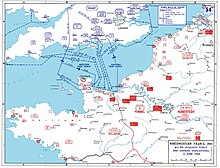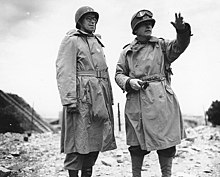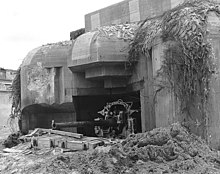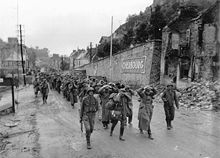Battle for Cherbourg
| date | June 14. bis 26. June 1944 |
|---|---|
| place | Normandy , France |
| output | allied victory |
| Parties to the conflict | |
|---|---|
| Commander | |
| Troop strength | |
|
VII Corps with 4th Infantry Division , 9th Infantry Division , 79th Infantry Division |
LXXXIV. Army Corps with 91st Infantry Division (only parts), 77th Infantry Division (only parts), 243rd Infantry Division (only parts), 709th Infantry Division (only parts) |
| losses | |
|
not exactly known |
not exactly known |
The Battle of Cherbourg took place in World War II during the Battle of Normandy in June 1944. Originally, the Allies intended to capture the French city of Cherbourg in Operation Neptune along with other important cities in Normandy such as Caen . However, due to the stubborn resistance of the German troops, they were not able to take Cherbourg until June 27, 1944.
initial situation
Even before the USA entered the war in December 1941, an involvement in the European theater of war was foreseeable. At the Washington Conference in 1941, Franklin D. Roosevelt and Winston Churchill confirmed that a landing on the European continent would be required, via the Mediterranean , from Turkey to the Balkans, or by landings in Western Europe . The war against the German Wehrmacht was given priority over the Pacific war against Japan .
In order to relieve the Red Army , Joseph Stalin had urged the Western Allies to open a second front . At the Tehran Conference in November 1943, landings in northern and southern France (Operations Overlord and Anvil ) were therefore decided. In contrast to Winston Churchill, who, ostensibly due to a lack of transport, urged that Operation Anvil be abandoned, Stalin favored the originally planned pincer movement. The Red Army had used this tactic successfully on several occasions. The Americans also thought an invasion of southern France would make sense, as the ports of Toulon and Marseille would offer good supplies and supplies for the Allied troops in France. The implementation of a simultaneous invasion of southern France (Operation Anvil) was abandoned and carried out as Operation Dragoon in August 1944.
At the Casablanca Conference , in the absence of Stalin, it was decided to establish a combined headquarters, the Supreme Headquarters Allied Expeditionary Force . The leadership of the Supreme Allied Commander should Dwight D. Eisenhower accept. Eisenhower's chief of staff was, under the designation Chief of Staff to the Supreme Allied Commander , the Lieutenant-General ( Lieutenant General ) Frederick E. Morgan , who should lead the planning for Operation Overlord. Bernard Montgomery took command of the land units . The naval forces were to command Admiral Bertram Ramsay , the air forces Air Chief Marshal Trafford Leigh-Mallory . The main goals were to take the big cities of Caen , Bayeux , Saint-Lô and Cherbourg in the planning.
The battle
The way to Cherbourg
After the American units that landed at Utah and Omaha Beach banded together and captured Carentan, they advanced on Cherbourg. The VII US Corps was to seal off the Cotentin peninsula from the north and west in order to be able to conquer Cherbourg.
The German units were outnumbered, but were able to slow down the advance of the Allied units because they used the terrain and the bocage landscape for themselves, although Omar Bradley provided the troops on the Cotentin well with supplies and reinforcements.
On June 14, the 4th US Infantry Division managed to break through the German main line of defense in the north, despite strong resistance. In the west, US VII Corps also made slow progress as they had to cross the Merderet and Douve rivers .
On June 15, General J. Lawton Collins , commander of the US VII Corps, reinforced the American forces advancing west of the Merderet with the 82nd Airborne Division , under Matthew Ridgway , and the US 9th Infantry Division , the was under the command of Manton S. Eddy .
The German units withdrew a little to shorten their defensive front, which enabled the 82nd Airborne Division to capture Saint-Sauveur-le-Vicomte after they had previously managed to cross the Douve on June 16 . Collins then saw the opportunity to get to the coast quickly. He ordered the US 82nd Airborne Division and the US 9th Infantry Divisions to advance along the main roads west to the coast. The two divisions surprised the Germans with their rapid advance and reached the coast in the night of June 17th to 18th. The German units did not have sufficient forces for an organized counterattack.
Most of the towns and villages were largely destroyed by Allied bombardment, artillery fire and the fighting.
The Americans then advanced north, conquering Montebourg and Valognes and the main road leading to Cherbourg. On June 20, the Germans withdrew to the city of Cherbourg.
The battle for the city
In January 1944, Hitler designated the most important port cities in the west as 'fortresses'; an above all symbolic act. Cherbourg was partly developed like a fortress. The defenses consisted of various bunkers, concreted machine gun, grenade launcher and artillery positions.
On June 20, the Americans reached the outer defensive ring. Your scouting and raiding parties were initially thrown back. Given the well-developed defensive positions, Collins was hoping for demoralized and poorly equipped soldiers within the fortress. Thereupon Collins called on the German General Karl-Wilhelm von Schlieben , the commandant of the city, to surrender on June 21st. However, von Schlieben refused.
On June 22nd, the Americans attacked the defensive positions. At around 12:40 p.m. Mustang and Typhoon fighter-bombers attacked the city with bombs and their on-board weapons . This was followed by a bombing raid by 562 fighter bombers at around 1 p.m., but their bombs also hit American troops due to blown markings. At around 2 p.m. there was a bombardment by 377 medium bombers.
After artillery and tank shelling, American infantrymen and storm pioneers attacked the city. The storm pioneers systematically switched off the defenses, while soldiers with machine guns fired at the loopholes, thus preventing the Germans from resisting. When the storm pioneers got to the bunkers, they blew up the bunker doors with shaped charges and switched off the crews with phosphorus grenades .
On June 23, the German associations launched isolated counter-attacks and continued to offer resistance. The Americans continued to advance and bombarded the city with artillery and bombs. On June 25, in addition to the artillery and the bombers, three battleships and four cruisers took part in the bombardment. Among them the battleship USS Texas, which switched off at least one gun in the Hamburg position. In the battle with the fortress "Hamburg" all ships were damaged, the Americans suffered losses of 130 men.
As a result of the heavy artillery fire, the VII US Corps managed to get into the city center. The Germans then destroyed the city's port facility so that it would not fall into the hands of the Allies. Some strongly fortified positions still offered resistance on June 26th, but the Germans no longer fought in a coordinated manner.
Karl-Wilhelm von Schlieben, who was appointed in command of the Cherbourg Fortress on June 23, 1944, decided to surrender three days later, on the evening of June 26, 1944. After his surrender together with Rear Admiral Walter Hennecke , the commandant of the Normandy Sea Defense , to the 9th US Infantry Division under Major General Manton S. Eddy , von Schlieben surrendered with over 800 other soldiers in his underground command bunker in St. Sauveur and was then taken prisoner . A second, official, capitulation followed in the castle of Servigny , the headquarters of General Collins.
The German positions, which were still resisting, were persuaded to surrender on June 27 with loudspeaker announcements stating that the surrender had been signed. The same day, Collins handed over to the mayor of Cherbourg at the town hall one from parachute silk made tricolor . On June 29, the last defenders were also under Allied control.
A total of around 10,000 German soldiers were taken prisoner of war. American losses were around 2,800 dead and 3,000 missing. In addition, the Americans had about 13,500 wounded. On July 1st, all of northern Cotentin was in American hands.
The defenders did not fight as fanatically as required, for example, in OKW orders of February 1944 for the defense of fortresses. It was ordered to fight 'to the last man' and not to surrender under any circumstances.
reconstruction
The port of Cherbourg was blocked by various ships, mined and largely destroyed. First the Allies cleared the mines with minesweepers and divers , after which the sunken ships were salvaged to make the port navigable again. In addition, rubble and destroyed buildings had to be removed or repaired.
After fifteen days, the port was repaired to the point that it could be used again. However, the whole port was only fully repaired after three months of work day and night.
Gilles Perrault described the port as " the most important supply line for the Allied forces ". On September 7th, 23,000 new American soldiers landed in Cherbourg to be transported to the front. From October 15, more than 20,000 tons of equipment were handled every day, after which the port became the largest transshipment point in the world on November 2, with 133 ships docking and one million gross registered tons , which, however, was exceeded by two million gross registered tons in February 1945 could be.
Aftermath and commemoration
Since the Germans had destroyed the port facilities before the surrender, the Allies could not use the port as planned. Bradley was able to concentrate on the breakout from Normandy after the capture of Cherbourg and started Operation Cobra on July 24th . After the success of this operation and the Battle of Caen , the Allies succeeded in enclosing many of the German formations in the so-called Falaise pocket. The Battle of Cherbourg and the other battles in Normandy helped the Allies to establish a solid base in northern France, whereupon they were able to successfully complete the Battle of Paris and later also conquer Germany.
There are also various memorials in and around Cherbourg that commemorate the costly battles.
Liberation Museum
In Cherbourg, in Fort du Roule , on the hill of Roule, which dominates the city geographically, at a height of 117 m, is now the Musée de la Liberation de Cherbourg , which opened in 1954 and is the oldest museum in Normandy, remembering the events during of Operation Overlord, as well as the German occupation. At about 800 sq.m. 500 objects, maps and documents are shown. One focus is the Resistance as well as National Socialist propaganda.
literature
- Georges Bernage: Cherbourg: Premiere Victoire Americaine en Normandie . Heimdal, Bayeux 1990.
- William B. Breuer: Hitler's Fortress Cherbourg . Stein and Day, New York 1984.
- RPW Havers: Battle Zone Normandy: Battle for Cherbourg . Sutton, 2004, ISBN 0-7509-3006-3 .
- Andrew Rawson: Battleground Europe: Normandy - Cherbourg . Pen and Sword, Barnsley 2004.
- Roland Ruppenthal: Utah Beach to Cherbourg . Battery Press, Nashville 1984.
- Tony Hall (Ed.): Operation "Overlord" . Motorbuch, 2004, ISBN 3-613-02407-1 .
Web links
- Detailed presentation of the Battle of Cherbourg on www.normandie1944.de
- Army Department side to the museum
Individual evidence
- ↑ https://www.youtube.com/watch?v=9eoJCs3_Q9g
- ↑ Peter Lieb : Conventional war or ideological war? Warfare and the fight against partisans in France 1943/44 , Oldenbourg Verlag 2007, page 484.
- ^ Yves Lecouturier: Discovery Paths - The Beaches of the Allied Landing , p. 96, ISBN 3-88571-287-3 .










